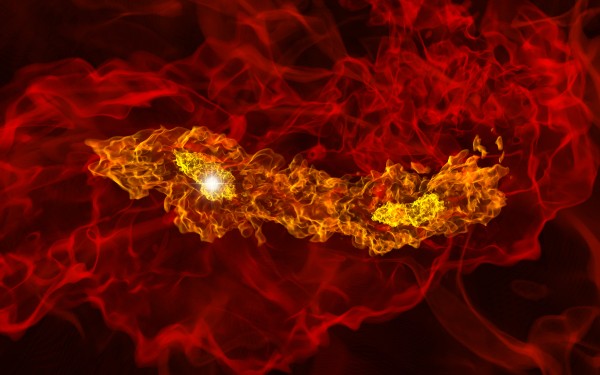July 17, 2025 - congratulations to Dr. Gina Vasey, who just successfully defender her dissertation, "Bridging Plasma Scales Using Data-Driven Model Identification"! Gina was co-advised by myself and Professor Andrew Christlieb, and will be starting a postdoctoral position this fall (details TBD as of the writing of this entry). Well done, Gina! We're proud of you and all that you've accomplished!
A picture from the post-defense celebration, with (L to R)
Andrew Christlieb, Gina Vasey, and Brian O'Shea:
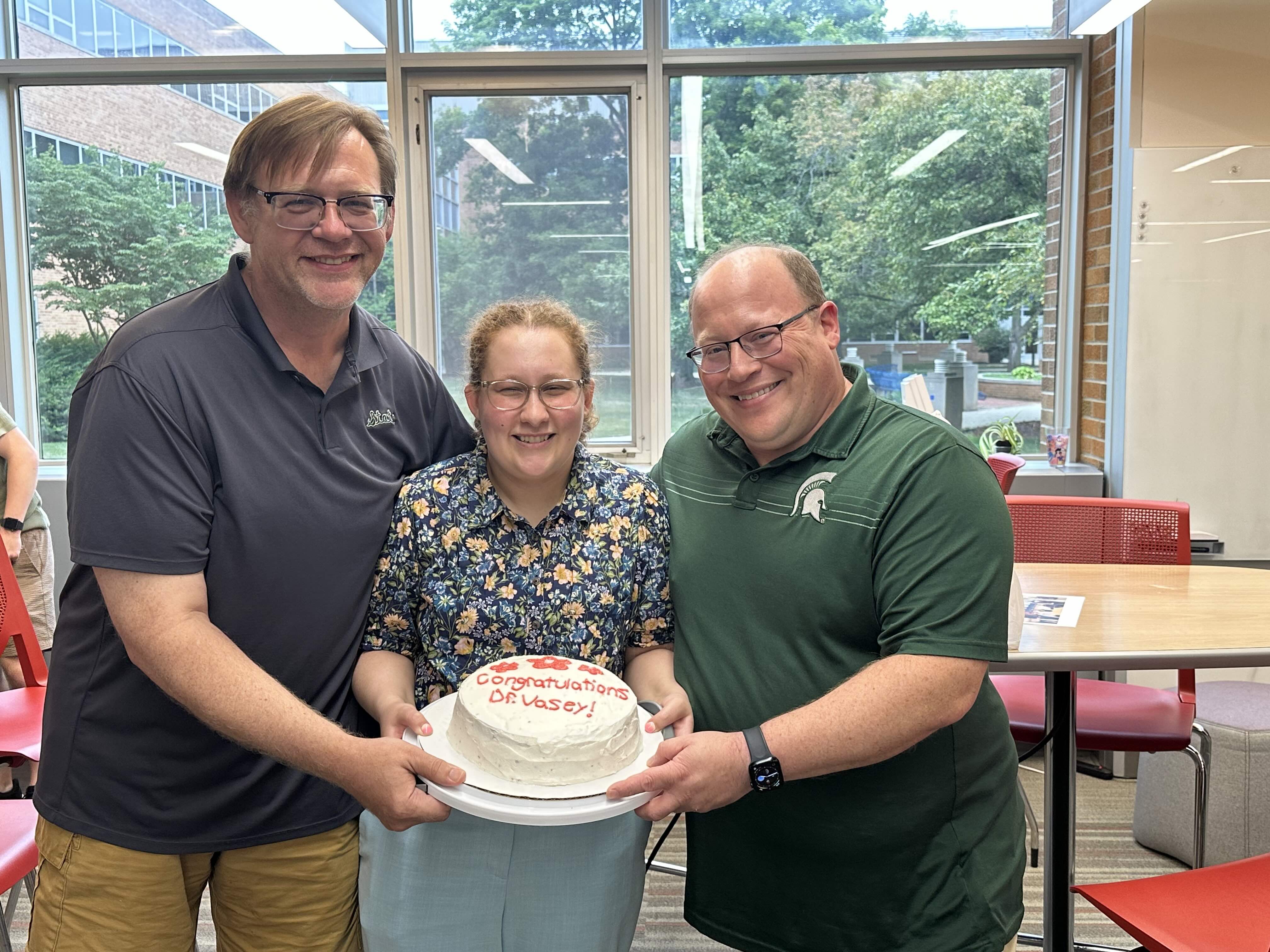
A picture from the MSU spring doctoral degree convocation
ceremony (L to R is the same as above):
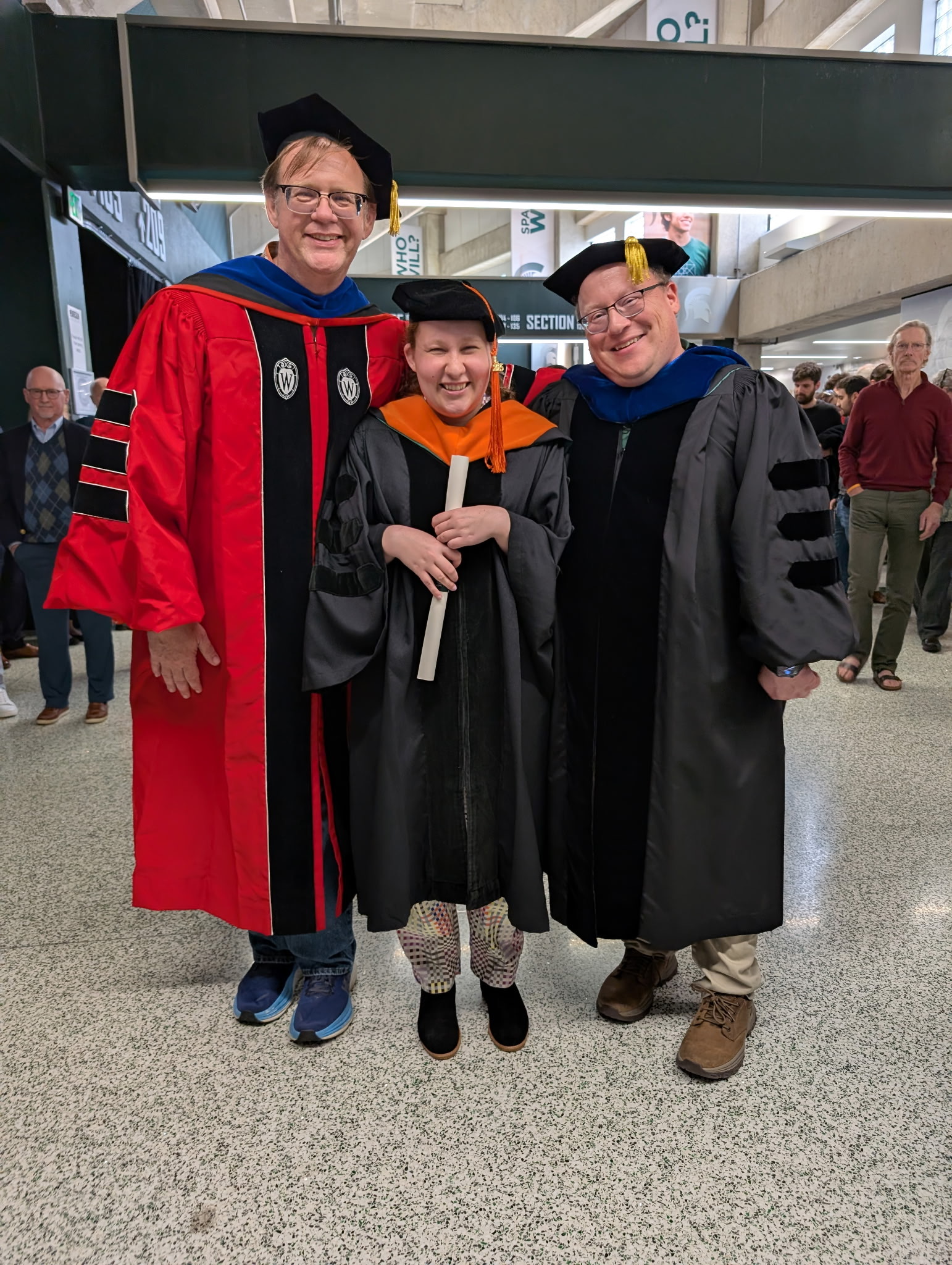
July 1, 2025 - the workshop Algorithms For Multiphysics Models In The Post-Moore's Law Era was a huge success! We had approximately 150 participants from the DOE national labs and a wide range of universities across the US and internationally, and a ton of excellent talks, posters, and discussions. You can find talk slides and posters at the workshop schedule web page.
March 1, 2025 - Gina Vasey's paper, "Influence of initial conditions on data-driven model identification and information entropy for ideal MHD problems" was just published in the Journal of Computational Physics. The goal of this paper was to examine how an algorithm for determining the governing equations of a physical system, the "Weak Sparse Identification of Nonlinear Dynamics" (WSINDy) algorithm, acts on ideal MHD test problems as the initial conditions are varied. It also identifies challenges with doing so, and specifies limiting requirements for successful equation identification. Congratulations, Gina!
February 2, 2025 - I am the lead organizer of the workshop Algorithms For Multiphysics Models In The Post-Moore's Law Era, which will take place in Los Alamos, New Mexico, from June 2-13, 2025. If you are interested in computational modeling at the largest scales - particularly the intersection between computing hardware, algorithms, machine learning, artificial intelligence, and applications - please submit an abstract!
January 1, 2025 - I will be spending roughly half of my time from January 2025 - July 2025 at the Los Alamos National Laboratory Center for Nonlinear Studies as a CNLS Ulam Scholar. While I'm working there I will be building collaborations with LANL staff, working on high energy density physics, doing code development, and organizing a workshop on multiphysics modeling in the post-exascale world.
November 15, 2023 - The second half of our DOE INCITE Leadership Computing grant, 600,000 node-hours on the Frontier exascale supercomputer, has been awarded to a collaboration including Dr. Forrest Glines (LANL), Dr. Philipp Grete (Hamburg Observatory), Dr. Deovrat Prasad (Cardiff), Dr. Ben Wibking (MSU), and myself. The DOE announcement can be found here.
Sep. 29, 2023 - several doctoral research opportunities are available in my group starting in August 2024, particularly relating to computational galaxy evolution, computational plasma physics, and data science approaches to modeling complex physical systems. The open positions are described at this page. If you find these positions interesting and would like to discuss opportunities, please email me to arrange a time to talk!
August 9, 2023 - The Institute for Cyber-Enabled Research (ICER), MSU's research computing facility, was featured in an MSU Today article called "Secret Science", which highlights some of the exciting research and facilities on MSU's campus. The video created as part of the article's media package is very cool. In addition to featuring ICER, the MSU Observatory is discussed as well!
The MSU today article also mentions an ICER article, "A Day in the Life of a System Administrator", which features a video about Kelly Climer, one of ICER's system administrators:
July 10, 2023 - the last paper from Dr. Claire Kopenhafer's PhD dissertation, "Seeking Self-regulating Simulations of Idealized Milky Way-like Galaxies", has just been published in the Astrophysical Journal. The goal of this paper was to understand how Milky Way-like galaxies self-regulate their star formation. Congratulations, Claire!
May 9, 2023 - I am pleased to announce the launch of the MSU Bioinformatics Core facility, which is a collaborative effort of bioinformatics consultants from the Institute for Cyber-Enabled Research, the Research Technology Support Facility, and the Biomedical Research Informatics Core. The goal of the Bioinformatics Core is to support researchers by analyzing complex -omics data, integrating data from multiple methodologies, and providing a meaningful biological context for the results. We will partner with researchers through all stages of the research process - from grant development and experimental design through data analysis, manuscript creation, and user training. I will be its interim founding Director.
For more information about the Bioinformatics Core please watch this short video and visit https://bioinformatics.msu.edu/. To schedule a meeting with a bioinformatics consultant please click the “Request consultation” button on the website or email bioinformatics@msu.edu.
March 16, 2023 - an article about our DOE INCITE project to study the interaction between supermassive black holes and massive galaxies was featured on MSU Today! It's a great article, and does an excellent job of explaining our work.
January 10, 2023 - our paper "As a Matter of Dynamical Range - Scale Dependent Energy Dynamics in MHD Turbulence" has been published in the astrophysical journal, led by Dr. Philipp Grete (formerly at MSU; now at the Hamburg Observatory. The goal of this paper was to examine the consequences of varied dynamic range in magnetohydrodynamic turbulence simulation using the implicit large eddy simulation (ILES) regime, and demonstrated that (1) we can accurately calculate the effective numerical viscosity and resistivity of these ILES calculations, and (2) can demonstrate that these simulations are resolved and have a corresponding equivalent explicitly viscuous and resistive calculation. In addition, we demonstrated that the means by which energy is transferred across scales is not constant as the simulation dynamical range increases (i.e., as the number of grid cells separating the driving scale from the dissipation scale get bigger), even up to simulations with 2,048 cells per dimension.
December 13, 2022 - MSU Today wrote a feature article about a new NSF National Research Traineeship grant that I am co-leading (along with Prof. Daniel Appelo and several other CMSE and Mathematics faculty at MSU). The goal of this project is to train graduate students to solve complex science and engineering modeling problems using machine learning and artificial intelligence techniques. MSU received a three million dollar, 5-year grant to develop coursework and directly support students, and is one of 22 institutions to receive this type of award in 2022. (An NSF news release is also available.)
December 6, 2022 - congratulations to Drs. Forrest
Glines and Claire Kopenhafer, who attended their PhD graduation
today! Dr. Glines will be moving to Los Alamos National Laboratory
as a Metropolis Postdoctoral Fellow, and Dr. Kopenhafer will
stay at Michigan State University to work as a Research
Consultant at the Institute for Cyber-Enabled Reseach.
Congratulations to both of you - I'm very happy for you, and
proud at how well you've both done!
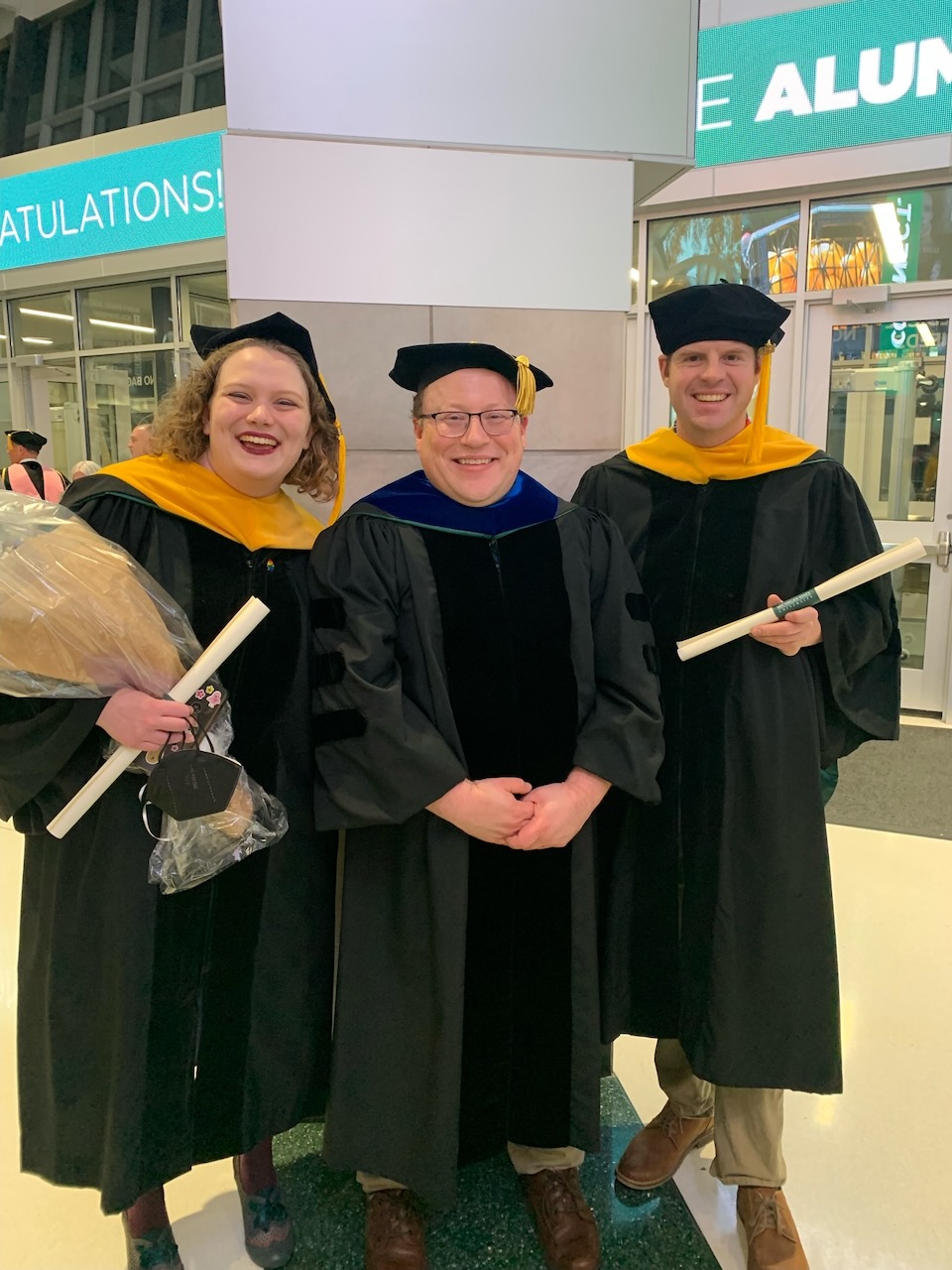
November 17, 2022 - MSU Today wrote a feature article about the Department of Energy-sponsorted Center for Hierarchical and Robust Modeling of Non-Equilibrium Transport, or CHaRMNET. The overarching goal of this $15M, 5-year project (of which I am one of the co-PIs) is to make numerical modeling of plasma systems more accurate and reliable, with the ultimate goal of modeling multiscale, multiphysics fusion energy systems. This project is led by MSU and Los Alamos National Laboratory, and brings together researchers from several universities and national laboratories.
November 15, 2022 - Along with Drs. Forrest Glines, Philipp Grete, and Deovrat Prasad, I have received an award from the Department of Energy INCITE Leadership Computing program for a project entitled "Feedback and energetics from magnetized AGN jets in galaxy groups and clusters". The goal of this project is to understand how galaxies evolve and regulate themselves, and to do so by simulating the feedback from supernovae and supermassive black holes on the diffuse plasma that surrounds galaxies (and in particular focus on the most massive galaxies in the universe). We will, for the first time, fully utilize the capabilities of the Frontier exascale supercomputer to explore the self-regulation of massive galaxies in groups and clusters using magnetized jet feedback from supermassive black holes.
As part of this project, we were awarded 1.23 million node-hours on Frontier, the world's first exascale supercomputer. We will begin the two-year simulation campaign in January 2023 and it will carry on through the end of 2024. The DOE announcement of these awards can be found here.
Sep. 22, 2022 - several doctoral research opportunities are available in my group starting in January 2023 or August 2023, particularly relating to computational galaxy evolution, computational plasma physics, and data science approaches to modeling complex physical systems. The open positions are described at this page. If you find these positions interesting and would like to discuss opportunities, please email me to arrange a time to talk!
July 29, 2022 - as part of the Summer 2022 cohort of the Advanced Computational Research Experience (ACRES) REU, Alexis Rollins (from the University of Alabama) and Elias Taira (from MSU) joined my group to work on research projects aimed at understanding the uncertainties related to understanding quasar absorption line observations of the circumgalactic and intergalactic media. Their primary mentor was Claire Kopenhofer, a dual astrophysics-CMSE PhD student in my research group. Both Elias and Alexis presented posters on their work (at Mid-SURE 2022 and in the Department of Physics and Astronomy's REU poster session, respectively) and gave talks about their work to my research group and (in Elias' case) to the ACRES REU cohort and their research mentors. Their posters are:
- Alexis Rollins: "Changing Elemental Abundance Assumptions Does Not Change Simulated Observations of the CGM"
- Elias Taira: "Simulating Variable UV Background Impacts on CGM Metal Column Densities"
After this summer, Alexis will return to the University of Alabama to work with Professor Jeremy Bailin and Elias will continue working with my group. Congratulations on a very successful summer to Alexis, Elias, and all of the ACRES and Physics and Astronomy REU students! Also, congratulations to Claire for being such a great mentor this summer!
July 5, 2022 - Dr. Deovrat Prasad, who has been working with Professor Mark Voit and I as a postdoctoral researcher for the past few years, is wrapping up his time at MSU and will be moving to Cardiff University where he will be working with Dr. Freeke van de Voort using a variety of simulations to study galaxy formation. While at MSU he was busy leading our group in studies of the impact of feedback from supermassive black holes on galaxy groups and clusters (Phoenix cluster paper; Environmental dependen of self-regulating black hole feedback in massive galaxies; Atmospheric circulation in massive galaxies; and more coming soon!). Congratulations, Deovrat!
April 21, 2022 - The National Science Foundation has awarded Michigan State University a grant to build the MSU Data Machine - an accessible supercomputer designed for data-intensive research and machine learning and artificial intelligence applications. An important feature of this machine is that both its user interface and user support (such as training and documentation) will make it as easy as possible for researchers who are new to data-intensive computing to make effective use of the machine, which will support ICER's commitment to building an inclusive and equitable campus culture around computing. The NSF award information can be found here; an article about this project can be found here. We anticipate that the hardware will arrive at MSU in late Fall 2022, and the machine will be available in Spring 2023.
April 14, 2022 - Forrest Glines, a member of my research group, has just successfully defended his doctoral dissertation entitled Numerical Simulations of Plasmas in Galaxy Clusters. As part of his dissertation work he studied thermal AGN feedback in galaxy clusters (paper 1), the development of performance-portable software tools for simulating magnetohydrodynamic systems (paper 2), the properties of decaying magnetized turbulence (paper 3), high-order methods for relativistic hydrodynamics (paper 4), and extremely high resolution simulations of magnetized AGN feedback in galaxy groups and clusters (which is not yet published). In September 2022 he will join Los Alamos National Laboratory as a Nicholas C. Metropolis Postdoctoral Fellow. Congratulations, Dr. Glines!
April 6, 2022 - the Institute for Cyber-Enabled Research has created a video giving a 360 degree tour of MSU's supercomputer at the MSU Data Center!
March 1, 2022 - MSU IT Services has released its 2020-2021 annual report, which features a video segment on the new MSU High-Speed Research Network, which was funded in part by an NSF Campus Cyberinfrastructure grant (award #2018432) that was co-led by myself and Melissa Woo (MSU's forner CIO and current Executive Vice President for Administration). The primary goal of this new network is to enhance MSU researchers' ability to move and share large amounts of data with collaborators, other members of their scientific communities, and the public. IT Services put together a video describing this project, which can be found here:
Feb. 4, 2021 - Dr. Philipp Grete, a postdoctoral researcher who has been a member of the group for the past four years, has received a Marie Skłodowska-Curie Actions Postdoctoral Fellowship for his proposal Unraveling effects of anisotropy from low collisionality in the intracluster medium . Starting in Fall 2021 he will officially join the group of Professor Marcus Brüggen at the Hamburg Observatory. While at MSU, Philipp has led efforts in studying driven magnetized turbulence (Energy transfer paper; turbulent driving paper; thermodynamics paper; magnetic tension paper) as well as the development of performance portable tools for simulating magnetohydrodynamic systems (K-Athena paper; Parthenon paper). Congratulations, Dr. Grete!
July 24, 2019 - three students from MSU's Advanced Computational Research Experience (ACRES) program worked in my research group this summer, doing amazing work relating to computational astrophysics along with their postdoctoral mentors. They presented posters of their work at the annual Mid-Michigan Symposium for Undergraduate Research Experiences (Mid-SURE). Their posters are:
- Aurora Cossairt (College of Idaho), mentored by Dr. Philipp Grete: "Understanding Energy Transfer In Plasma Turbulence".
- Sebastian Lacayo (Florida International University), mentored by Dr. Deovrat Prasad: "Energy Partition of AGN-ICM Interaction".
- Carleen Markey (Purdue University), mentored by Dr. Benoit Côté: "Emulating Galactic Chemical Evolution Models to Explore the Galactic Origins of the Elements".
Congratulations on a very successful summer to Aurora, Sebastian, Carleen, and all of the ACRES students!
July 24, 2019 - The Department of Computational Mathematics, Science, and Engineering was featured on MSU Today in a video entitled "Using big data to solve the world's biggest challenges." You can see the video here:
July 1, 2019 - as of today, I am the new Director of MSU's Institute for Cyber-Enabled Research (ICER)! ICER operates MSU's supercomputer as well as a range of related research support services. I'm very excited to take on this role, and to see how I can help ICER serve MSU's research and teaching missions.
June 8, 2019 - the paper "A Learner-Centered Approach to Teaching Computational Modeling, Data Analysis, and Programming", by Dr. Devin Silvia (in the Department of CMSE), Dr. Brian Danielak (former CMSE postdoc, currently at Fullstack Academy), and myself, was just published in the Proceedings of ICCS 2019. This paper describes the creation of CMSE 201, “Introduction to Computational Modeling and Data Analysis,” which is a course at MSU that teaches students core concepts in data analysis, data visualization, and computational modeling. More broadly, it discusses the education-research-based rationale behind the “flipped classroom” instructional model that we have chosen to use in CMSE 201, which has also informed the design of other courses taught in the department. We also explain the course’s design principles and implementation. All course materials for CMSE 201 are available to interested educators - please contact me if you would like a copy!
May 10, 2019 - the paper "K-Athena: a performance
portable structured grid finite volume magnetohydrodynamics
code," written by Dr. Philipp
Grete, Forrest Glines (an MSU doctoral student), and
myself, was just submitted to the journal IEEE Transactions on
Parallel and Distributed Systems, and is available
on the arXiv. This paper describes our efforts to combine
Athena++,
an existing magnetohydrodynamics (MHD) CPU code, with Kokkos, a
performance portable on-node parallel programming paradigm,
into K-Athena to allow efficient simulations on multiple
architectures using a single codebase. This project was very
successful, with K-Athena achieving more than 108
cell updates/s on a single NVidia V100 GPU for second-order
double precision MHD calculations, and a total of almost 2
trillion cell updates/second at 76% parallel efficiency on 24,576 GPUs on the DOE
Summit supercomputer! A plot of the single-CPU and single-GPU
performance of K-Athena, Athena++, and GAMER (a CUDA-based MHD
code using similar algorithms) can be seen here, for a variety
of architectures:
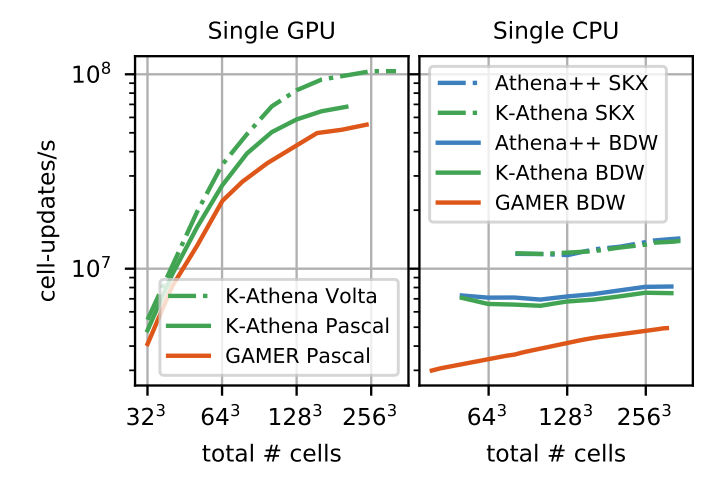
The weak scaling and parallel efficiency of K-Athena and Athena++
can be seen here:
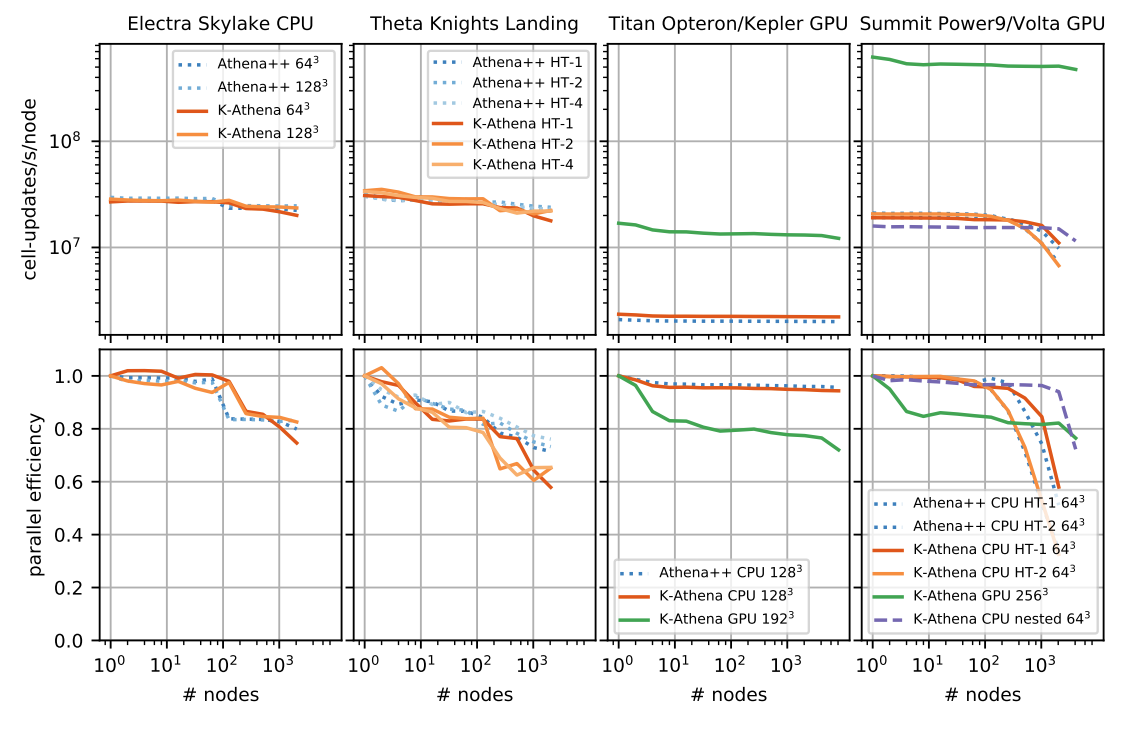
(Note: click either plot for a larger version with a more detailed caption.) The K-Athena code is publicly available, and suggestions and contributions are welcome!
July 31, 2017 - A fly-through of an evolving population of galaxies in the early universe, made from the Renaissance Simulations (e.g., O'Shea et al. 2015 and many other papers) and created by the NCSA Advanced Visualization Laboratory, has been submitted to the SC17 visualization competition. The movie is shown below.
June 20, 2017 - Philipp Grete's new paper, "Energy transfer in compressible magnetohydrodynamic turbulence", has been submitted to the journal Physics of Plasmas and has been placed on the arXiv. In this paper, we extend the shell-to-shell energy transfer analysis that was previously used for incompressible magnetized fluids into the compressible magnetohydrodynamic (MHD) regime. This allows us to explore energy transfer between the kinetic and magnetic components of compressible turbulence, as transferred by gas pressure and advection and magnetic pressure and tension. We do so with both sub- and super-sonic turbulence simulations and show that this method demonstrates the complex nature of energy transfer in compressible MHD turbulence, as well as highlighting differences between numerical methods and sonic regimes.
June 1, 2017 - the final paper from Greg Meece's PhD dissertation has appeared in the Astrophysical Journal. The paper is "Triggering and Delivery Algorithms for AGN Feedback", by Meece, Voit, and O'Shea. Congratulations, Greg!
May 15, 2017 - Kirk Barrow's new paper with the Renaissance Simulations, " First light: exploring the spectra of high-redshift galaxies in the Renaissance Simulations", has appeared in Monthly Notices of the Royal Astronomical Society. In this paper we present synthetic observations for the first generations of galaxies in the Universe and make predictions for future deep field observations for redshifts greater than 6. Due to the strong impact of nebular emission lines and the relatively compact scale of HII regions, high-resolution cosmological simulations and a robust suite of analysis tools are required to properly simulate spectra. We created a software pipeline to generate synthetic IR observations from a fully three-dimensional arrangement of gas, dust, and stars. Our prescription allows us to include emission lines for a complete chemical network and tackle the effect of dust extinction and scattering in the various lines of sight. We provide spectra, 2D binned photon imagery for both HST and JWST IR filters, luminosity relationships, and emission-line strengths for a large sample of high-redshift galaxies in the Renaissance Simulations. Our resulting synthetic spectra show high variability between galactic haloes with a strong dependence on stellar mass, metallicity, gas mass fraction, and formation history. Halos with the lowest stellar mass have the greatest variability in observational properties , while haloes with higher masses are seen to show much greater consistency in said properties. Furthermore, JWST colour plots show a discernible relationship between redshift, color, and mean stellar age.
January 1, 2017 - The paper "GRACKLE: a chemistry and cooling library for astrophysics", by Britton Smith et al., just appeared in the journal Monthly Notices of the Royal Astronomical Society. grackle is an open-source chemistry and radiative cooling library for astrophysical simulations and models. It has interfaces for many of the programming languages typically used in astrophysics (including Python, Fortran, C, and C++), and is extremely flexible. The source code for grackle, and for the method paper, can be found here.
July 14, 2016 - Brian Crosby has received his PhD! Brian is a PhD student here at MSU. He successfully defended his dissertation, "Semi-analytic modeling of stellar populations in astrophysical simulations", today. Congratulations to Dr. Crosby! He will be going on to pursue a career doing computational modeling in the alternative energy industry. In addition, his most recent paper, "Tracing the Evolution of High-redshift Galaxies Using Stellar Abundances", appeared in the Astrophysical Journal recently.
April 29, 2016 - Greg Meece has received his PhD!
Greg is a PhD student here at
MSU that has been co-supervised by Mark Voit and myself. He
successfully defended his dissertation, "AGN Feedback and
Delivery Methods for Simulations of Cool-Core Galaxy
Clusters", today. Congratulations to Dr. Meece! He will
go on to pursue a career as a data scientist in the medical
industry. In addition, the final chapter of his thesis, Triggering
and Delivery Algorithms for AGN Feedback, has been
submitted to The Astrophysical Journal and is currently under
review.
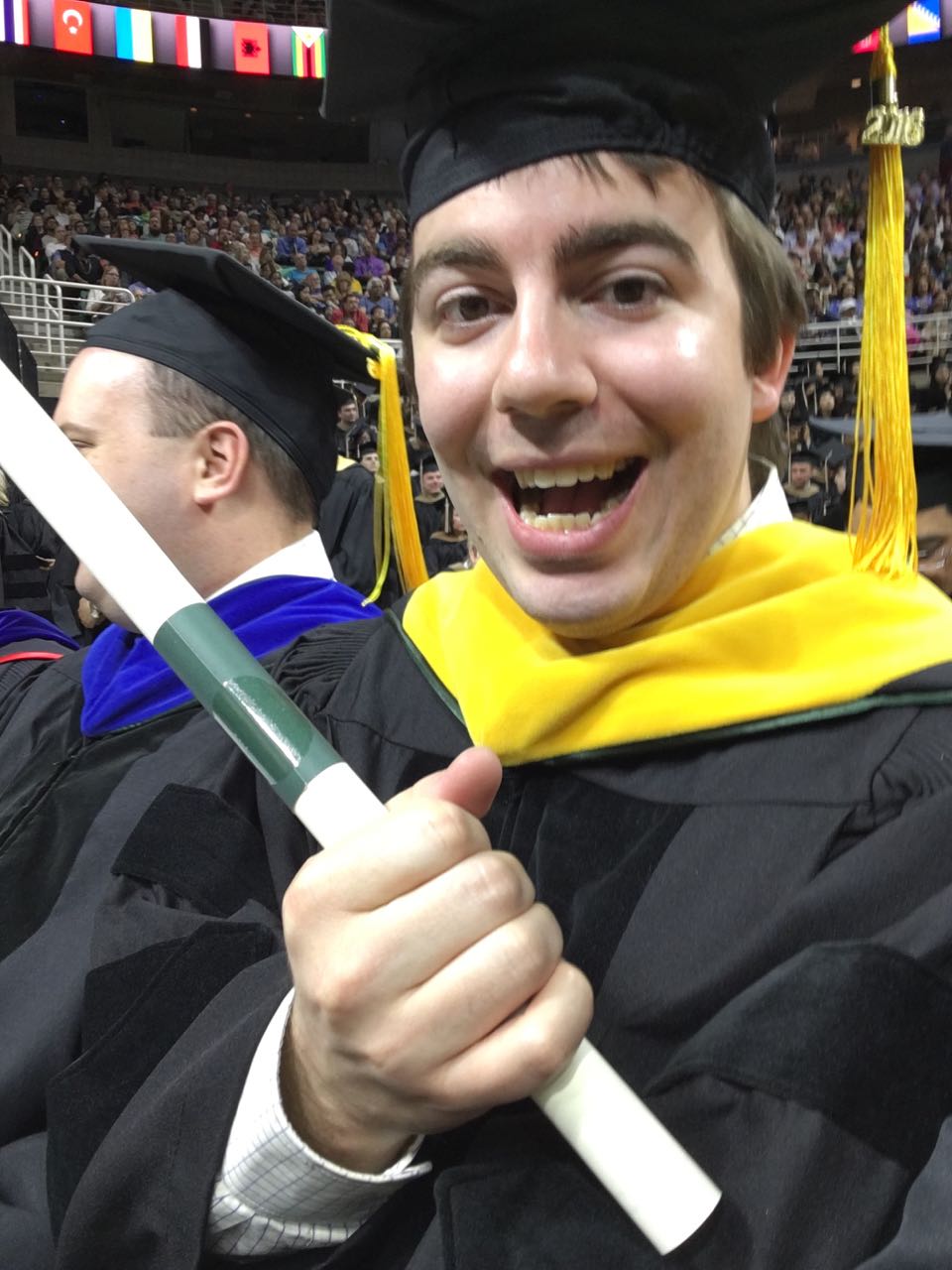
August 12, 2015 - The cosmology simulation gallery
has been updated to include movies and images from a
simulation zooming in on a
Local Group-mass halo at z=0. The dark matter density at
the final simulation output can be seen below (click to go to
the image gallery):
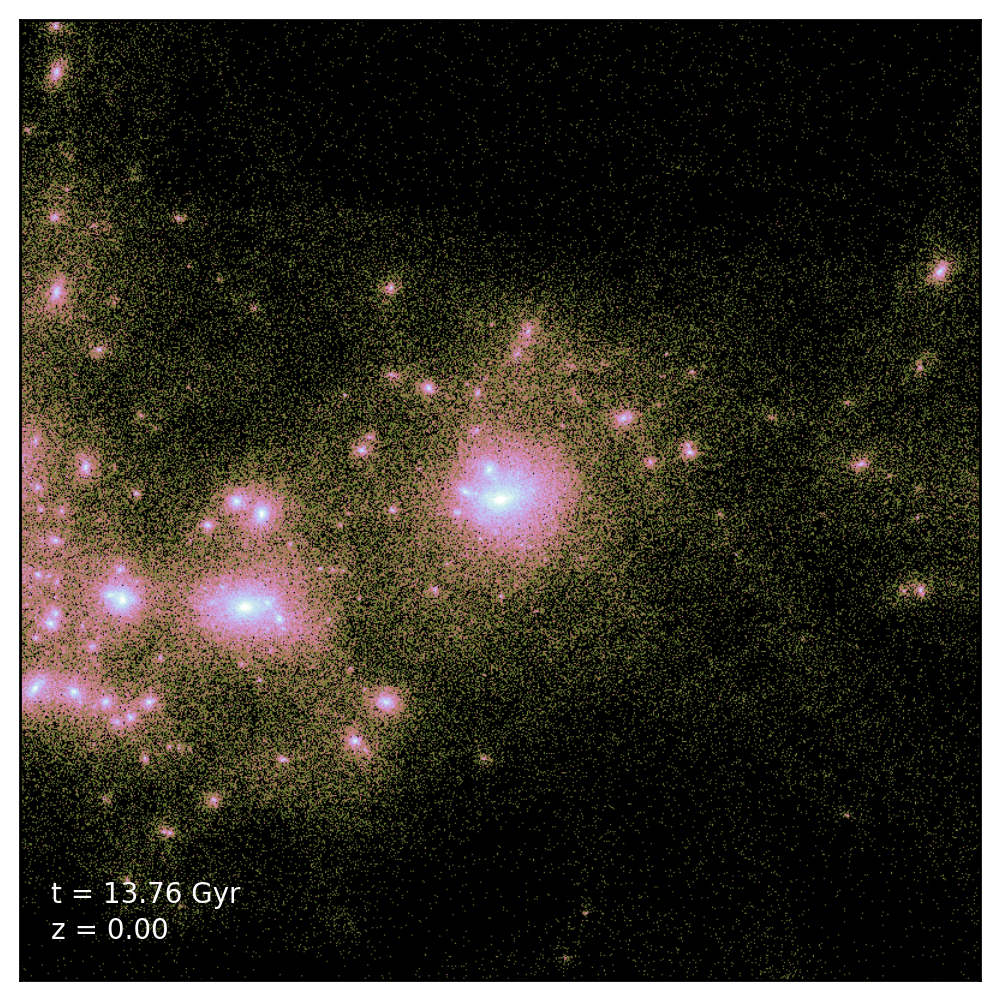
August 1, 2015 - Our paper, "The first Population II stars formed in externally enriched mini-haloes", by Britton Smith et al., has just been published in Monthly Notices of the Royal Astronomical Society. In this paper, we present a simulation of the formation of the earliest Population II stars, starting from cosmological initial conditions and ending when metals created in the first supernovae are incorporated into a collapsing gas cloud. This occurs after a supernova blast-wave collides with a nearby mini-halo, inducing further turbulence that efficiently mixes metals into the dense gas in the centre of the halo. The gas that first collapses has been enriched to a metallicity of 2 × 10-5 ZSun. Due to the extremely low metallicity, collapse proceeds similarly to metal-free gas until dust cooling becomes efficient at high densities, causing the cloud to fragment into a large number of low-mass objects. This external enrichment mechanism provides a plausible origin for the most metal-poor stars observed, that appear to have formed out of gas enriched by a single supernova. This mechanism operates on shorter time-scales than the time for low-mass mini-haloes (masses less than 5 × 105 MSun) to recover their gas after experiencing a supernova. As such, metal-enriched stars will likely form first via this channel if the conditions are right for it to occur. We identify a number of other externally enriched haloes that may form stars in this manner. These haloes have metallicities as high as 0.01 ZSun, suggesting that some members of the first generation of metal-enriched stars may be hiding in plain sight in current stellar surveys.
The movie below (created by Britton Smith) shows the evolution of the cosmological simulation. The left panel shows the gas density and the right panel shows the temperature. The first Pop III star forms at redshift 23.7 and shines for roughly 4 Myr before exploding as a core-collapse supernova, at which time the right panel changes to show the metallicity. About 60 Myr after the first supernova, the movie zooms in on the formation site of the second Pop III star. Shortly after it explodes, the supernova blast-wave collides with a nearby halo moving in the opposite direction. The passing blast-wave and a merger event induce turbulence, which allows the metals from the supernova to mix into the center of the halo. The movie then continues to zoom in to follow the dense gas in the core of the halo as it undergoes runaway collapse. For much of the collapse, we only see the central core become smaller and denser. Eventually, dust cooling becomes efficient, causing the gas to cool quickly and fragment into multiple clumps. The movie ends at a scale of 100 proper AU looking at the pre-stellar cores that will go on to form the first low-mass stars. I strongly suggest watching this movie in "full screen" mode, and you can also see it on vimeo.com.
July 1, 2015 - Our paper "Probing the Ultraviolet Luminosity Function of the Earliest Galaxies with the Renaissance Simulations", by O'Shea et al., just appeared in The Astrophysical Journal Letters. In this paper, we present the first results from the Renaissance Simulations, a suite of extremely high-resolution and physics-rich AMR calculations of high-redshift galaxy formation performed on the Blue Waters supercomputer. These simulations contain hundreds of well-resolved galaxies in the very early universe (within the first several hundred million years of the Big Bang), and make several novel predictions. Most critically, we show that the ultraviolet luminosity function of our simulated galaxies is consistent with observations of high-z galaxy populations at the bright end of the luminosity function, but at lower luminosities is essentially flat rather than rising steeply, as has been inferred by extrapolating observational data. This behavior of the luminosity function is due to two factors: (i) the strong dependence of the star formation rate (SFR) on halo mass in our simulated galaxy population, with lower-mass halos having systematically lower SFRs and thus lower UV luminosities; and (ii) the fact that halos with virial masses below roughly 200 million solar masses do not universally contain stars, with the fraction of halos containing stars dropping to zero at rougly 7 million solar masses . Finally, we show that the brightest of our simulated galaxies may be visible to current and future ultra-deep space-based surveys, particularly if lensed regions are chosen for observation.
The image below (Figure 4 from the paper) highlights some properties of the galaxy properties that come out of the Renaissance Simulations. This image shows Matter overdensity (top row) and ionized fraction (bottom row) for the three regions simulated in the Renaissance Simulations. The red triangles represent the locations of galaxies that are detectable with the Hubble Space Telescope. Its successor, the James Webb Space Telescope, will detect many more distant galaxies, shown by the blue squares and green circles. These first galaxies reionized the universe only one billion years after the Big Bang, shown in the image with ionized (blue) bubbles around the galaxies. Image: Brian W. O'Shea (Michigan State University), John H. Wise (Georgia Tech); Michael Norman and Hao Xu (UC San Diego).
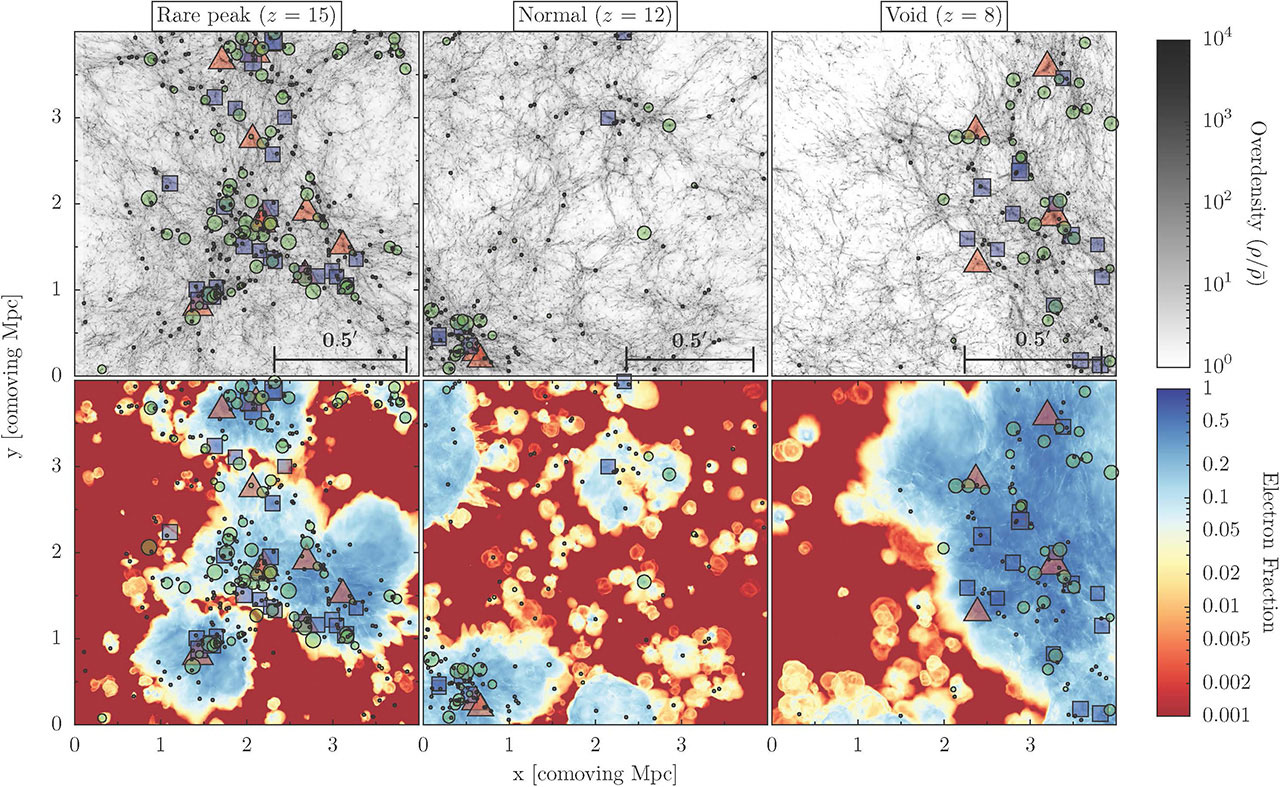
July 6 followup: MSU, Georgia Tech, UC San Diego, and NCSA issued press releases about this paper, which have garnered quite a bit of media attention (Science Daily, io9, UCSD, GA Tech, Futurity, NCSA).
May 31, 2015 - as part of the Caterpillar Project, my collaborator Dr. Brendan Griffin (a postdoc at MIT) has made a movie of the first 24 simulations to be completed (see below). The Caterpillar Simulations are high resolution dark matter simulations of the formation of Milky Way-sized galaxies, and are intended to be the platform for a wide variety of studies relating to galaxy evolution. The movie embedded below shows the evolution of these dark matter halos over the age of the universe, and it highlights the differences in formation history between galaxies that will, at the present day, be approximately the same mass. (Note: the movie is best viewed full screen and at the highest possible resolution.)
April 14, 2015 - MSU has announced the formation of a new Department of Computational Mathematics, Science and Engineering (CMSE). This department will bring together researchers from a wide variety of disciplines and will significantly advance efforts in computational and data science at MSU. It will also offer both undergraduate and graduate students courses and degree programs focusing on computational modeling, data analysis, and related topics.
I will be one of the founding members, with a joint appointment between CMSE and the physics department as of August 2015. The article announcing the department's formation can be found here (and the tweet announcing it is ). This is the group official portrait of the founding members of the department:
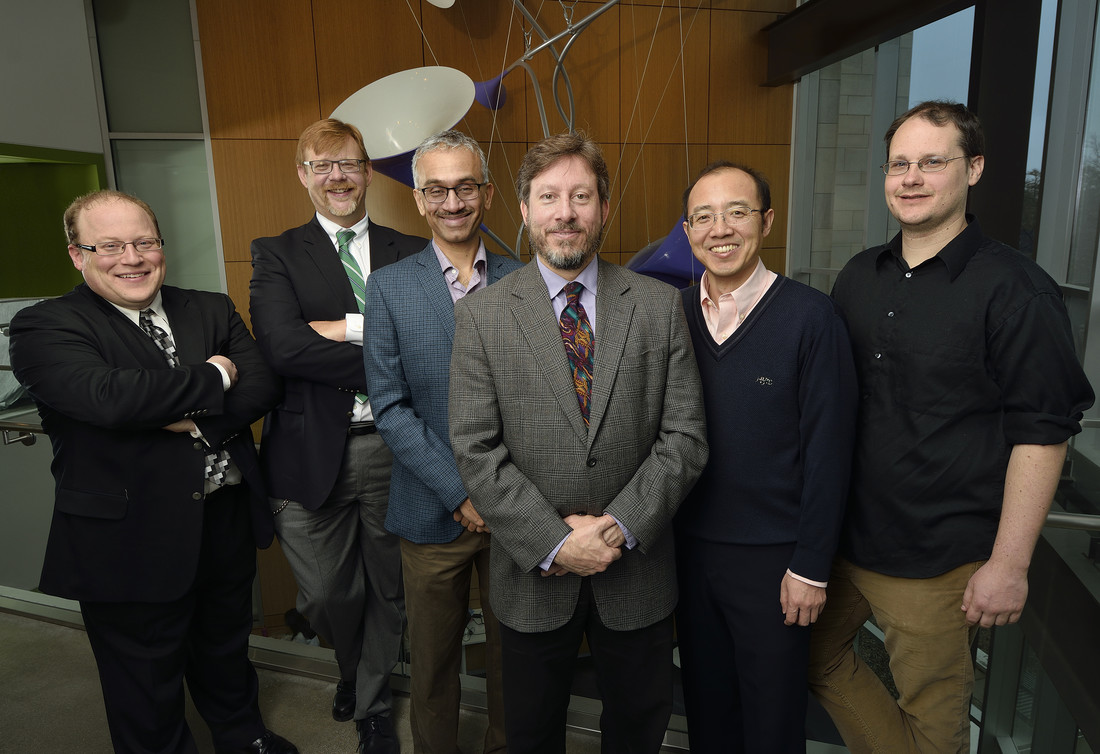
March 30, 2015 - I was a panelist in the MSU Honors College's "Sharper Focus/Wider Lens" cross-disciplinary panel on "The Next Revolutions." The Honors College posted a podcast with each speaker's speech on what they thought the next revolution will be. Mine was on "The Data Revolution", and the slides are available here. The podcast is here:
And the video of the entire event is here:
March 14, 2015 - I gave the NCSA Director's Colloquium on the work that the Enzo PRAC collaboration has done using the Blue Waters supercomputer. This talk, entitled "The Universe in a Box: Modeling cosmological structure formation with Blue Waters", can be found online here:
and the slides can be found online here (pdf).
March 5, 2015 - my group, and an extended collaboration including scientists at the University of Michigan, Georgia Tech, Florida State, Notre Dame, and the University of Edinburgh have been awarded an allocation on the Blue Waters supercomputer as part of the Great Lakes Consortium for Petascale Computation's annual allocation. The purpose of this allocation is to do simulations of the formation of Milky Way-type galaxies, and builds off previous work done by our collaboration in both high-redshift and local universe calculations.
February 11, 2015 - my group's research has been highlighted by MSU's Institute for Cyber-Enabled Research. The article from this research highlight can be found here, and the video is below:
An older article can be found here.
February 10, 2015 - I am one of the four recipients of the 2015 MSU Teacher-Scholar Award, which was awarded at the University award ceremony today. A video of the ceremony can be found here, and I make an appearance at roughly 35:50.
November 4, 2014 - the second paper from our Blue Waters simulations, entitled "Scaling Relations for Galaxies Prior to Reionization", by Chen et al., was just published in the Astrophysical Journal. This paper looks at scaling relations for 3,300 of the very earliest galaxies, which formed during the first stages of reionization, and examines galaxies having virial masses betwen 106 and 109 solar masses. In this paper we show that galaxy formation is not solely relegated to atomic cooling halos with virial temperatures greater than 104 K, but we find a dichotomy in galaxy properties between halos above and below this critical mass/temperature scale. The scaling relations presented here can be employed in models of reionization, galaxy formation, and chemical evolution in order to consider these galaxies forming prior to reionization.
The images below are from the simulation in question, and show (in order of appearance) the projection of baryon density, baryon temperature, and metallicity along the line of sight through the adaptively refined region of the simulation. The HII regions surrounding these galaxies, as well as the metal-enriched outflows from the same objects, can clearly be seen. (Images c/o Hao Xu, Pengfei Chen, and Michael Norman at UCSD; John Wise at GATech; and Brian O'Shea at MSU).
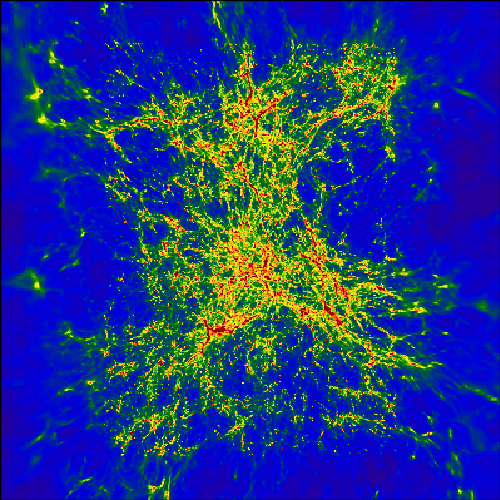
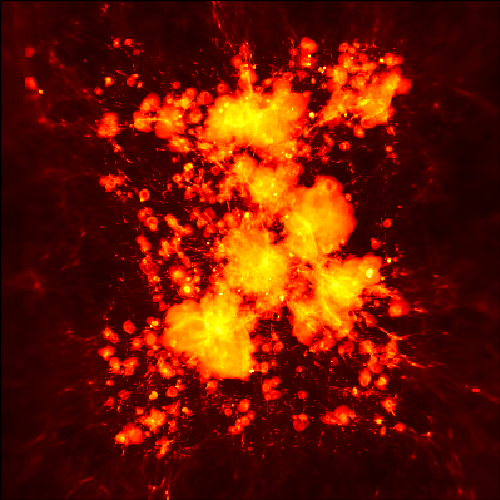
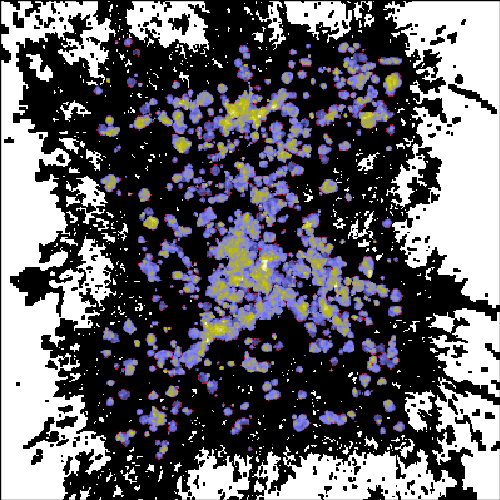
August 29, 2014 - an article featuring our first work using simulations from the Blue Waters supercomputer was just published in the Astrophysical Journal. This paper, entitled "Heating the Intergalactic Medium by X-Rays from Population III Binaries in High-redshift Galaxies", by Xu et al., explores the impact of X-rays produced by Population III X-ray binaries on the heating and ionization of the high-redshift intergalactic medium. We find that low-energy (≤ 1 keV) X-rays are quite efficient at heating the IGM, and can raise its temperature to over 100 K by z=10, with regions near the X-ray sources heated to 10,000 K. This may be important for predicting signals from neutral hydrogen as found by future 21 cm line experiments. On the other hand, the free electrons from X-ray ionizations are not enough to contribute significantly to the optical depth of the cosmic microwave background to the Thomson scattering.
August 28, 2014 - I am one of several faculty highlighted in MSU's "Pathways to Success" video, which will be shared with incoming faculty at the annual orientation event.
August 27, 2014 - I've posted several sets of movies of Enzo simulations, made using the yt analysis and visualization tool, which may be useful for talks. Both YouTube links and downloadable mp4 files are available, as well as still images for the cosmology simulations. See below:
August 4, 2014 - an article featuring the work of my current undergraduate research student, Claire Kopenhafer, is currently being featured on the Lyman Briggs College website and can be found here (addendum: it also appeared on the Honors College website . Claire is building tools to make synthetic Integral Field Unit (IFU) spectrograph measurements of simulated galaxies, which we plan to compare with observations made by the Keck Telescope's OSIRIS instrument and with the Sloan Digital Sky Survey MaNGA project. This type of measurement gives spectroscopic information about a galaxy in a spatially-resolved way, rather than measuring the entire galaxy as a whole, and can be used as a very effective tool to probe the behavior of both gas and stars within galaxies. We plan to use Claire's work to explore the entire life cycle of gas within galaxies. The two images below show (top) a projection of baryon density through a small region of the simulation volume that is centered on an interesting-looking galaxy, and (bottom) the Oxygen-III emission associated with the gas in the disk of the galaxy at a given wavelength. If you examine the wavelengths around this, you can find gas in the OIII state that is moving at different velocities along the line of sight, and by using several different ions (at a variety of wavelengths) one can get a great deal of information about how gas in various thermal phases behaves. (Note: simulation data graciously provided by Dr. Cameron Hummels.)
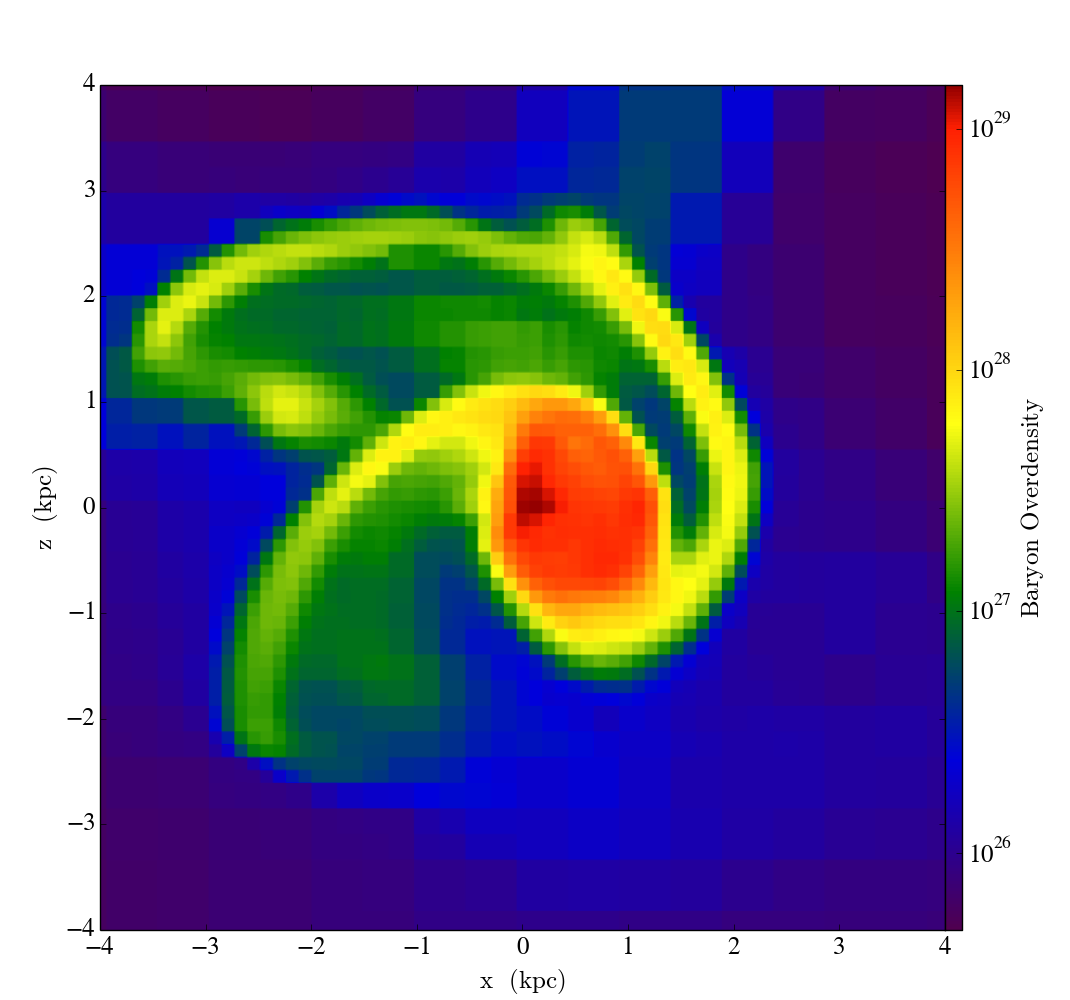
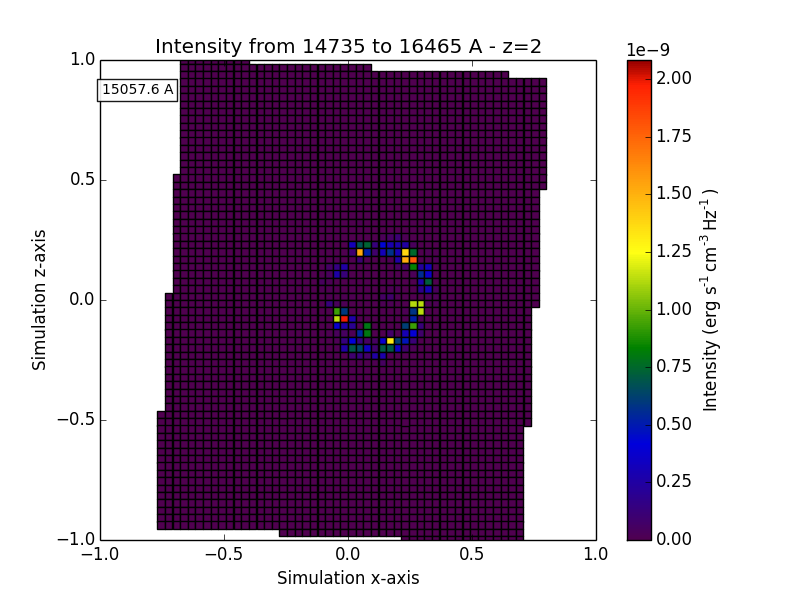
August 1, 2014 - my former undergraduate student Hilary Egan's article "Bringing Simulation and Observation Together to Better Understand the Intergalactic Medium" has appeared in The Astrophysical Journal. This paper explores different methods for characterizing absorption in simulations of the intergalactic medium. It also presents a pipeline for generating and fitting synthetic QSO absorption spectrausing sight lines cast through the same simulations, and compares the two techniques. We focus on HI and OVI, and our comparisons show that the two methods generally agree with each other, but are systematically different from observations for OVI absorption systems. The image below (Figure 1 in the paper) shows three different ways of identifying features: via absorption spectrum (top panel), via a 'cut' method (middle panel), where regions of constant width in redshift space are used, and a 'contour' method (bottom panel), where a threshold number density is used to determine the bounds of an absorber.
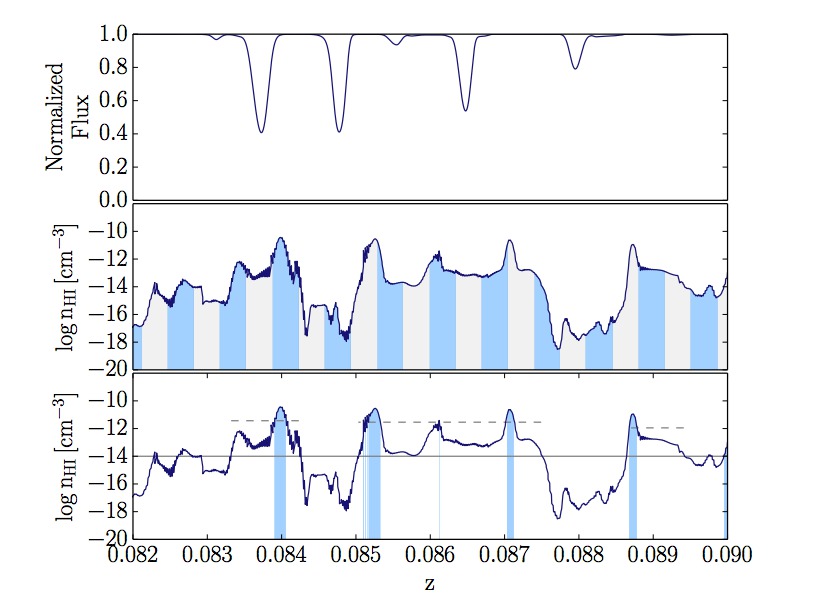
May 20, 2014 - My postdoc Facundo Gomez's article "Dissecting Galaxy Formation Models with Sensitivity Analysis—a New Approach to Constrain the Milky Way Formation History" has just appeared in The Astrophysical Journal. This paper uses a statistical tool known as "sensitivity analysis" to characterize the relationship between input parameters and observational predictions of semi-analytic models of galaxy formation. The result of this analysis provides the user with information about which parameters are most important and most likely to affect the prediction of a given observable. It can also be used to simplify models by identifying input parameters that have no effect on the outputs (i.e., observational predictions) of interest. Conversely, sensitivity analysis allows us to identify what model parameters can be most efficiently constrained by the given observational data set. We also apply this technique to more efficiently build statistical emulators for our models, which enables rapid exploration of parameter space. This work was done as part of the NSF-funded Modeling and Data Analysis Initiative and the Joint Institute for Nuclear Astrophysics.
April 1, 2014 - The Enzo method paper (formally titled "ENZO: An Adaptive Mesh Refinement Code for Astrophysics") has finally been published! The paper describes all of the algorithms in the Enzo AMR code, including physics, infrastructure (i.e., adaptive mesh and parallelization), and analysis algorithms. It also shows the outputs for a range of test problems, including the Double Mach test (shown in the figure below). The paper, referee report, our response, and scripts to generate all of the test problem figures found in the paper can be found in the Enzo method paper repository.

March 10, 2014 - my graduate student Greg Meece's first peer-reviewed journal article " Fragmentation in Dusty Low-metallicity Star-forming Halos", just appeared in the Astrophysical Journal. In this paper, we simulate the fragmentation of cooling gas in idealized, low-metallicity halos using the Enzo code. We conduct several simulations of 106 and 107 solar mass halos in which the metal content, initial rotation, and degree of turbulence are varied in order to study the effect of these properties on gas fragmentation over a range of densities. We find tentative support for the idea of a critical metallicity, but the effect of varying metallicity on the gas we observe is not as dramatic as what has been reported in earlier studies. It is theorized that at lower redshifts with a lower cosmic microwave background temperature, variations in metallicity might have a larger effect on cooling and fragmentation. We find no clear relation between the initial spin or the initial level of turbulence in the halo and the final properties of the gas contained therein. Additionally, we find that the degree to which the Jeans length is refined, the initial density profile of the gas, and the inclusion of deuterium chemistry each have a significant effect on the evolution and fragmentation of the gas in the halo - in particular, we find that at least 64 grid cells are needed to cover the Jeans length in order to properly resolve the fragmentation. The figure below (Figure 13 from the paper) shows projections of average density through the densest point in the simulation for runs with different metallicity for our 107 solar mass halo at the scales where the clump finder finds evidence of fragmentation in high-mass halos. Each projection has a width of 0.05 pc and is taken when the central density has reached 1010 cm−3. Substructure is evident in the higher-metallicity runs (shown in the bottom row), and the clump finder confirms that some of these structures may become gravitationally bound if cooling persists.
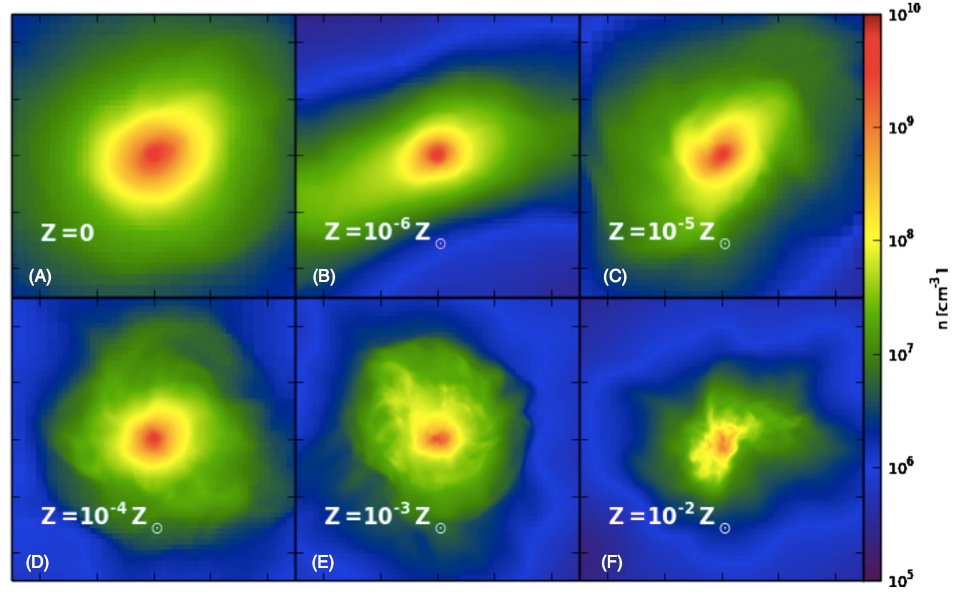
January 1, 2014 - the AGORA high-resolution galaxy simulation comparison project paper has now been published in the Astrophysical Journal! Details of the collaboration can be found at the AGORA project workspace. This includes initial conditions and yt analysis scripts.
August 7, 2013 - my graduate student Brian Crosby's first peer-reviewed journal article, "Population III Star Formation in Large Cosmological Volumes. I. Halo Temporal and Physical Environment," just appeared in the Astrophysical Journal. In this paper, we use semi-analytic models to identify dark matter halos that are capable of forming a Population III stars in cosmological simulations across a wide range of times and environments. Our models show that Population III and chemically enriched stars coexist beyond the formation of the first generation of stars in a cosmological simulation until at least z = 10, and likely beyond, though Population III stars form at rates that are 4-6 orders of magnitude lower than chemically enriched stars by z = 10. In addition, we explored the environments where primordial stars form, showing that over time Pop III star-forming halos become increasingly spatially isolated from one another and from metal-enriched halos at later times. The figure below (Fig. 5A from the paper) shows shows the variation in star formation rate density as a function of redshift for a wide range of models. The mean Pop III star formation density is plotted as a solid line, and the metal-enriched star formation density is plotted as a dashed line. The dark and light shaded regions show the 68% and 95% confidence regions of the models, respective.
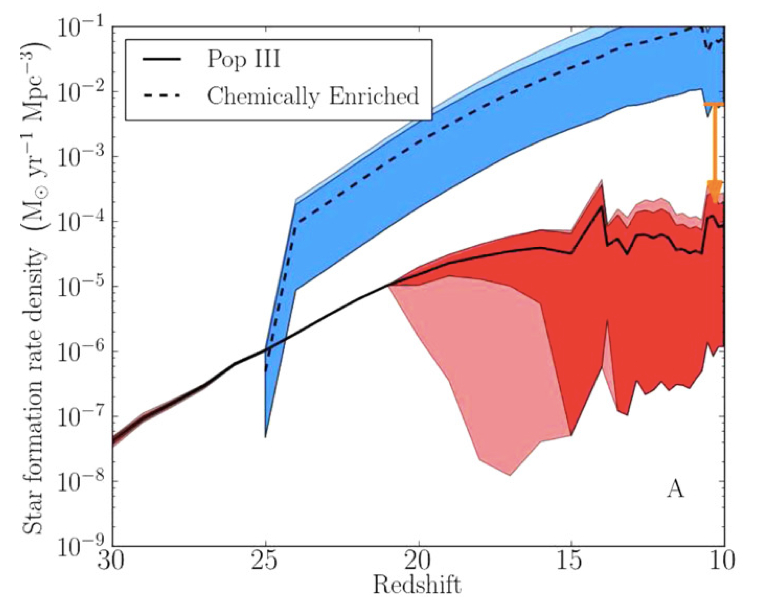
June 3, 2013 - My article "From F = ma to Flying Squirrels: Curricular Change in an Introductory Physics Course," by O'Shea, Terry, and Benenson, just appeared in the journal CBE Life Science Education as part of their special issue on the intersection of physics and biology. This paper details the curricular changes that have been made to an introductory calculus-based physics course sequence that I frequently teach, whose audience is primarily life science majors. We have implemented a "Physics of the Life Sciences" curriculum that emphasizes the relationships between physics and the life sciences, and helps students to learn to apply physical intuition to life science-oriented problems. This curriculum has been very successful, and students experience high conceptual learning gains and many report an increased interest in physics relative to before they enrolled in this course. The arXiv version of the paper can be found here, and the journal version can be found here. Curricular materials can be obtained by emailing me.
May 30, 2013 - My close collaborator Sam Skillman successfully defended his PhD today. His dissertation is entitled Adaptive Mesh Refinement Simulations of Cosmic Rays in Galaxy Clusters, and he now has a doctorate in astrophysics from the University of Colorado at Boulder. I had the privilege of being on his thesis committee, as well as on all of his thesis papers. He will be a KIPAC Postdoctoral Fellow at the Kavli Institute for Particle Astrophysics and Cosmology at Stanford University starting this fall. Congratulations, Dr. Skillman! While I don't have a picture of his graduation, due to the wonders of modern technology you can watch his thesis presentation from the comfort of your desk:
May 1, 2013 - My first graduate student, Carolyn
Peruta, successfully defended her PhD today. Her
dissertation is entitled Modeling Galactic Chemical
Evolution in Cosmological Simulations, and the results
will be appearing in print shortly. Carolyn's post-graduation
plans are to work in the Sonoma State University
NASA Education and Public Outreach Group, supporting
several NASA space science missions.
Congratulations, Dr. Peruta!
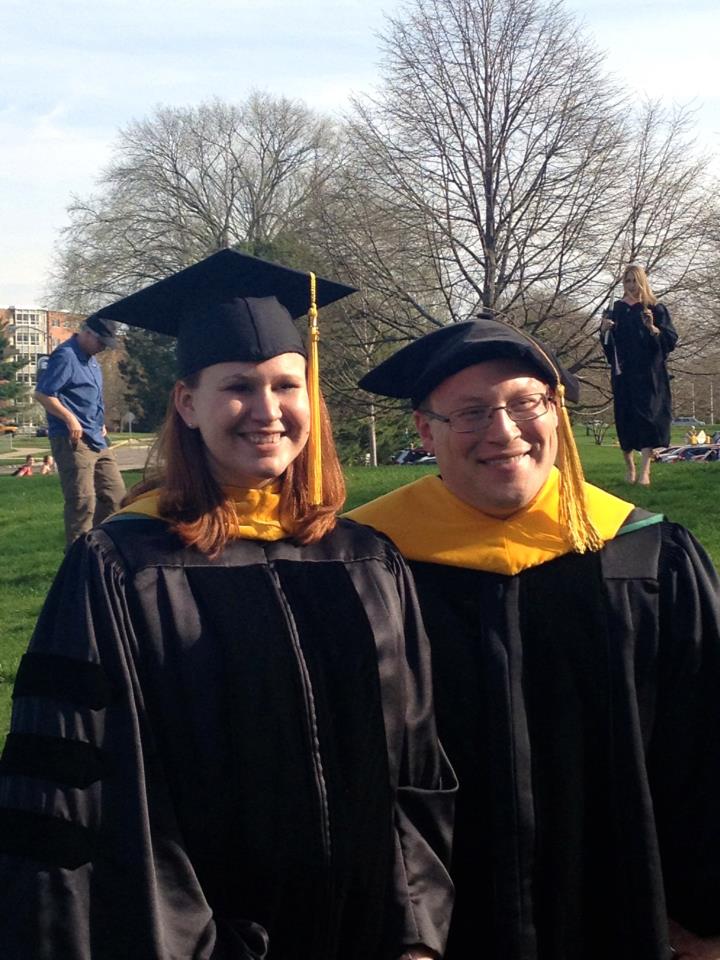
December 5, 2012 - The first astrophysics-focused paper from MSU's NSF-funded Modeling and Data Analysis Initiative (of which I am a co-PI) just appeared in the Astrophysical Journal. The paper, "Characterizing the Formation History of Milky Way like Stellar Halos with Model Emulators", uses a combination of semi-analytic models of galaxy formation and stastical emulation techniques to study the formation history of the Milky Way's stellar halo and dwarf galaxy population. This paper demonstrates the power of statistical emulation techniques, and suggests that there are substantial degeneracies between model parameters (such as the stellar initial mass function) and the formation history of the Milky Way galaxy that will be quite challenging to decouple.
July 11, 2011 - Our paper "Galaxy Cluster Radio Relics in Adaptive Mesh Refinement Cosmological Simulations: Relic Properties and Scaling Relationships", by Sam Skillmen et al., just appeared in the Astrophysical Journal. This paper shows that radio relics - extended radio features observed galaxy clusters - clearly come from the merger shocks associated with structure formation. In this paper, we also produce synthetic radio maps of a large sample of galaxy clusters and present luminosity functions and scaling relationships. This work is important for radio telescopes that observe at long wavelengths, such as LOFAR and the Long Wavelength Array. The image below, Figure 2 from the paper, shows a snapshot of the universe at the present day in (clockwise from top left) projected baryon density, temperature, 1.4 GHz radio emission, and shock mach number.
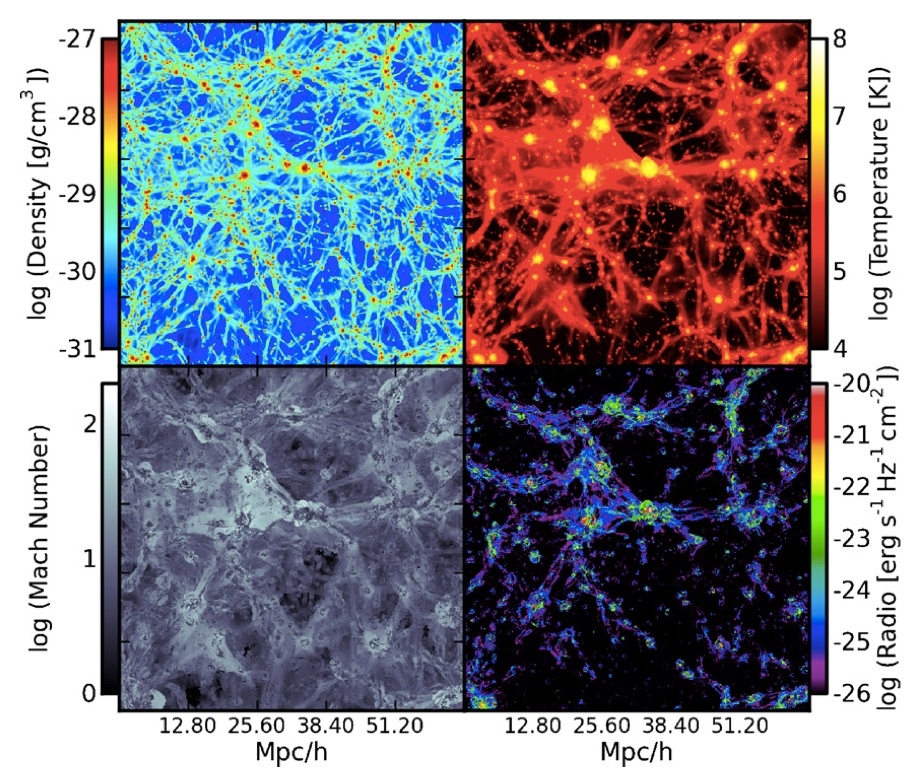
April 1, 2011 - Our paper "The Nature of the Warm/Hot Intergalactic Medium. I. Numerical Methods, Convergence, and O VI Absorption", by Britton Smith et al., just appeared in the Astrophysical Journal. This paper explores simulated properties of the "warm-hot intergalactic medium," which is gas that is between 105 and 107 K - a phase where almost half of the baryonic matter in the universe is expected to reside at the present day, and which is very challenging to observe. In particular, we focus on absorption lines of the OVI ion, which an be observed with the Hubble Space Telescope. In this paper, we demonstrate the minimum necessary set of numerical convergence criteria to adequately resolve the WHIM, the physical processes that are critical to do so, and also make predictions about the properties of gas in the WHIM phase. The image shown below, the right panel of Figure 21 in the paper, shows the mean temperature and baryon overdensity of OVI absorbers in the intergalactic medium, with the points colored by the OVI column density of the absorber. Lower-column absorbers tend to be in mildly overdense regions at a wide range of temperatures, whereas higher-column absorbers are typically in regions of higher overdensity (but with temperatures that are generally between 104.5 and 105.5 K). While OVI is not a perfect tracer of hot gas, it certainly provides an important probe of gas in the elusive WHIM phase.
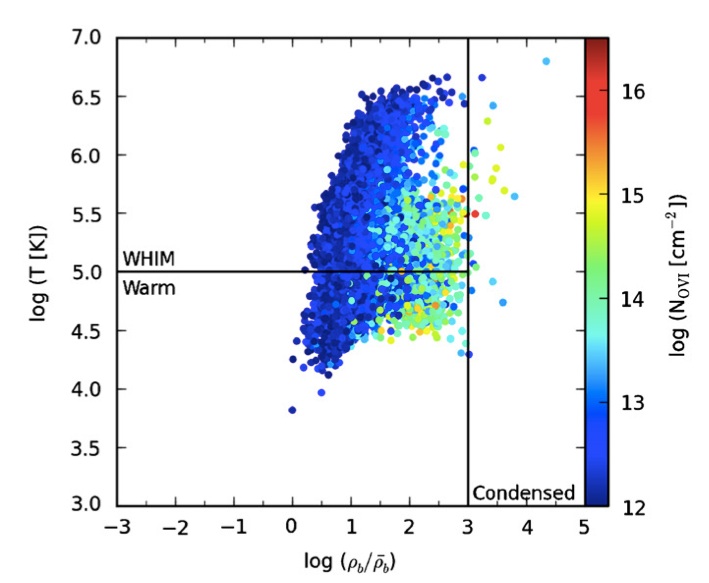
Oct. 19, 2010 - Videos of a simulation of the formation of a Milky Way-like galaxy, done by me using the Enzo code and visualized by the NCSA Advanced Visualization Laboratory, are currently featured on the James Webb Space Telescope Website. Direct links to movies using these calculations are here and here, and the longer video is embedded below.
November 12, 2009 - My research is featured on the NCSA Blue Waters website in an article entitled "Leaving the Dark Days", about high-redshift galaxy formation, as part of the Petascale Computing Resource Allocation Program.
July 31, 2009 - The paper The formation of Population III Binaries from Cosmological Initial Conditions, by Matthew Turk (UC San Diego/Stanford), Tom Abel (Stanford), and Brian O'Shea (MSU) was published today in the journal Science. This paper reports the first binary Population III (primordial composition) stars to be found in cosmological simulations of high-redshift structure formation, and suggests that the first generation of stars may in fact have been much less massive than previously thought. The article was accompanied by press releases by
Michigan State University and SLAC, and articles (with interviews of both Matthew Turk and Brian O'Shea) by space.com,
New Scientist,
Symmetry Magazine,
The State News, and
MSNBC, among others. The image below (produced by Ralf Kaehler), shows the gas cloud in which the binary stars have formed in our simulation. In this image, the field of view is about 2,000 astronomical units across (one astronomical unit is the distance between the Earth and the Sun, or about 93 million miles). The two yellow clumps are the gas clouds in which the two stars are being born. (Click on the image to view a larger version.)
